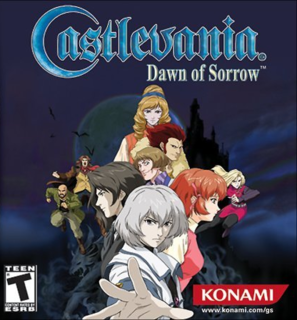Dawn of Sorrow is the best Metroid-style Castlevania game around. It also proves that 2D games have plenty of life!
Dawn of Sorrow (DoS hereafter) takes place one year after the events of Aria of Sorrow. Soma Cruz is living a normal life until he’s attacked by a cult who wants to revive the dark lord Dracula because he’s a necessary evil (no pun intended). Black has its white, yin has yang, the Jedi stand opposite to the Sith—the cult’s goal is to basically restore balance to the world. It doesn’t take long for Soma to get into the thick of things, and soon enough you’re in a huge castle, laying waste to every creature in existence. It’s all familiar territory, especially if you’ve played Aria of Sorrow prior. The Mega Man-like soul system returns, but it has been refined so that you can power up souls by collecting the same soul multiple times. You can also use souls to upgrade weapons, which cuts down on hunting for items, but at the same time increases the need for souls. The weapon system from Symphony of the Night is back; all weapons have a secondary ability which is easily accessed with the A button, as opposed to entering random d-pad commands. The secondary attack consumes magic, though, and is not worth using until you’ve leveled up quite a bit.
The graphics are excellent, and are the best of any 2D Castlevania game to date. Soma and his friends are now taller and animate better than before. Enemies are also animated well, and they still come in various sizes. The music is pretty good, though no Castlevania soundtrack after Symphony of the Night has been exceptional. The sound effects are what you would expect; they’re nice and clear, and there are bits of voice clips from both friends and foes (the way some characters say “Soma!” is funny).
For extra modes, you get the usual stuff, like boss rush and sound mode, but right from the start you get an enemy set mode, where you challenge your friends to run through your custom-made gauntlet of enemies. Future games could enhance enemy set mode to change the room types, or even allow the player to make their own rooms (one step shy of a “create-a-castle” mode). Best of all, though, is the Julius mode. This time, Konami actually put some thought into this mode type, and included a story, multiple playable characters with different skills, and the ability to level up. You even get a different final boss, which makes this mode worth the time to play through.
You’ve probably seen the complaint in other DoS reviews, but it bears repeating because it needs to be addressed: hunting for rare souls/items needs to be done in a way so that you don’t spend what could potentially be hours killing the same enemy over and over again. Here’s one possible solution: an item that makes the last enemy killed drop its soul when that enemy’s death results in raising your level. Another problem, though minor, is the use of the touch screen and the second screen. Having a map onscreen at all times is great, but you still have to pause to access the menu for other things. As it is now, all you can do is draw seals (a gimmick at best), break crystals (few rooms have them), and target enemies for your familiars (pointless). If Konami had switched the screens around, the touch screen could have been used exclusively for managing the menu and switching between different screens. Needless to say, DoS is not the best example of showcasing the DS’ touch screen capabilities, but ultimately it’s not a big deal, so don’t give it too much thought.
DoS stands as the best Metroid-style Castlevania to date. Its combination of great visuals and sound, refined gameplay, and nice extras make DoS another must-have for the DS. DoS is further proof that 2D is alive and well.

